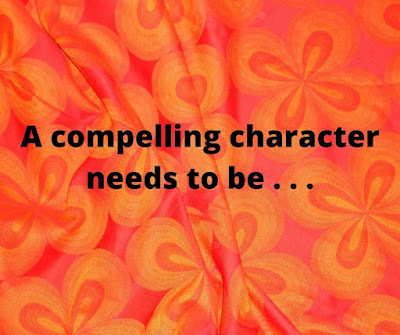Erica Vetsch's Blog, page 33
May 28, 2022
Sunday Scripture & Prayer Requests
THE ASCENSION
 Ascension, John Singleton Copley, 1775,
Ascension, John Singleton Copley, 1775,
Museum of Fine Art, Boston. [PS-US]
Jesus said to his disciples:
“Thus it is written that the Christ would suffer
and rise from the dead on the third day
and that repentance, for the forgiveness of sins,
would be preached in his name
to all the nations, beginning from Jerusalem.
You are witnesses of these things.
And behold I am sending the promise of my Father upon you;
but stay in the city
until you are clothed with power from on high.”
Then he led them out as far as Bethany,
raised his hands, and blessed them.
As he blessed them he parted from them
and was taken up to heaven.
They did him homage
and then returned to Jerusalem with great joy,
and they were continually in the temple praising God.
Luke 24:46-53
The Seekerville bloggers are praying for YOU and for our entire blog community. If you have any special intentions that need additional prayer coverage, leave a request for prayer in the comment section below.
Please join us in praying for our country and for an end to the rising economy. Also, please pray for the people of Ukraine, for a halt to Russian aggression, and for the protection of our military.GOD BLESS THE USA!
We are so grateful for all of you—for your friendship and your support!
May the Lord bless you and keep you safe.
May 27, 2022
Weekend Edition


If you are not familiar with our giveaway rules, take a minute to read them here. It keeps us all happy! All winners should send their name, address, and phone number to claim prizes. Please send to Seekerville2@gmail.com. If the winner does not contact us within two weeks, another winner may be selected.
Monday: Erica chatted with you about when a book goes into a second printing.
Tuesday: Guest Laurel Blount shared her thoughts on the power of connection. The winner of Her Mountain Refuge and the first book in the Cedar Ridge collection Lost and Found Faith is... Laura Conner Kestner!!!
Wednesday: Cate
Thursday: Pam
Friday Tasha Hackett was here teaching us how to listen when our characters speak.

Monday: Memorial Day - Seekerville pays a tribute to the fallen.
Wednesday: Mindy will be in the house and there's no telling what she'll have up her sleeve. Thursday: Audra Harders (MIA Seeker) has retired from her day job and is on the journey from daily grind to new found freedom. But, as good as it sounds to leave the 8 to 5 job behind in favor of uninterrupted writing, the process isn't so easy.

Coming August 23rd!Available for preorder now!
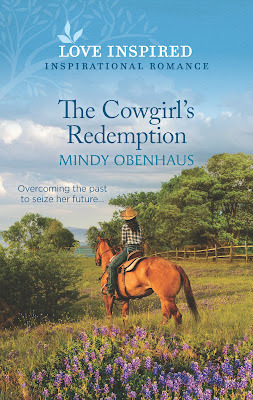
She came home to make things right. Will she be given a second chance?
Gloriana Prescott has returned to her Texas hometown to make amends—even if the townsfolk she left behind aren’t ready to forgive. But when her mother’s ranch manager, Justin Broussard, is tasked with saving the struggling rodeo so his teen daughter can compete, Gloriana sees a chance to prove she’s really changed. But can she prove to Justin, and the town, that she’s trustworthy?
And this just in...
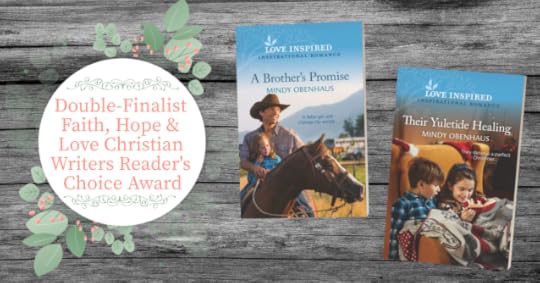

Michael Crichton's Method of Plotting for Plotting Out a Story by Angela Ackermann at Writers Helping Writers
Deadlines and Taxes by Steve Laube at Steve Laube Agency
How to Triage Your Writing by Addey Vaters at The Writing Cooperative
Book Marketing Strategies by Heidi McCahan at Book Brush Blog
Let It Be Ugly by Mollie Joy Rushmeyer at Learn How To Write A Novel
Losing the Plot: Writing by the Seat of Your Pants by Gwen Hernandez at Writer Unboxed
Promote Your Book with Your Values by Sonya Huber at Jane Friedman
What's the Big Deal About Cowboys? by Milla Holt at Inspy Romance
I've Had the Same Editor for 60 Years by Rick Lewis at The Writing Cooperative
Thoughts on Thoughts by Terry Odell at Kill Zone blog
May 26, 2022
Listen when Your Characters Speak
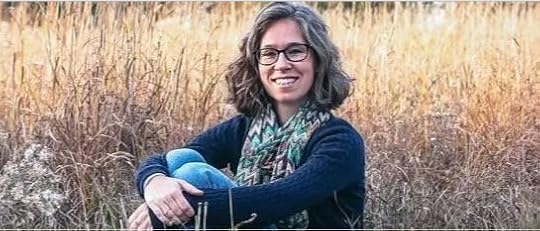
Hello, the camp! Tasha Hackett here, author of Bluebird on the Prairie and many more to come. Mary asked if I would share something I’ve learned as an author. Of course my first thought was: “Everything. Duh. I’ve learned everything.” I went from knowing nothing, to learning everything and still somehow knowing nothing. But aside from the tangible how-tos, I’ve learned how to listen when my characters speak.
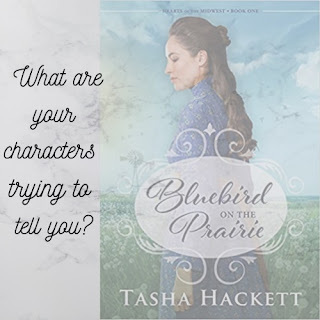
Chances are, they have a lot to say, and if you can figure out how to listen to them, you’ll get along much better. How often do you think you’ve made up a story in your own head with your very own make-believe characters, but then they’re off doing and speaking whatever they very well please? We would all do well to listen when our characters speak. I thought I was writing a story about this, but it turned out to be about this. Has that ever happened to you? Though I don’t have as many books under me as some of you, with one published, one drafted, and a thousand to be written, in my time writing these two books, I’ve learned how important it is to listen when my characters speak.
Bluebird on the Prairie started as a whim. My husband and I brainstormed a silly story where Zombie Apocalypse meets Hallmark Western Romance. If you know me at all, you’re already laughing. Tasha is not about to write a book about zombies. Vampires, maybe. Zombies, ew. Once I started writing, I got to know Zeke and Eloise and learned right away they had a story to tell about hope (that didn’t include zombies in any way, shape, or form.) Zombies were out and western was out. I was left with a Swedish prairie town in Nebraska, a widow living with her brother who’d shut herself away from love, and an orphaned traveler on his way to California.
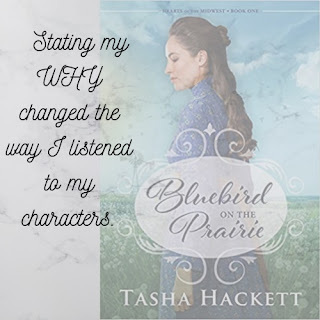
July 7, 2018. I wrote my WHY: “I want my reader to feel hope at the end. Because, to me, novels are an escape to a better place. A place where the hero is strong and brave. A place where people get back up again.
“I want the story to feel real, but I always want LOVE TO OVERCOME. I want God’s grace to expand into my imaginative world and show readers the vast goodness of God’s plan. I want my novels to inspire hope back into the lives of the readers.
“I want the reader to feel the truth of Eloise’s pain and grief and then grow WITH her as she begins to trust God. I want the reader to feel hope that God is real and that he not only sees, but cares and has a plan for us. And I will do it all with a story that pulls the reader into this world where they never feel they’re being preached at.”
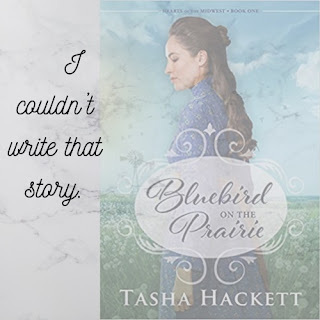
Listening to my WHY changed everything. I found I couldn’t write Eloise’s story. This was no longer a silly story where guy-meets-girl and they both run to their happily-ever-after. It suddenly became so much more and I was scared I couldn’t do Eloise justice. Eloise was a young widow, and I didn’t know how to give her a happily-ever-after. You can’t FIX grief. There’s no MOVING ON from grief.
Grief is an emotional suffering caused by or as if by a bereavement. An emotional suffering when something you love has been taken away. How could I write this happily-ever-after for Eloise? The more I got to know her, the more I realized I could NOT send a man to waltz into her life and make everything better. I just wasn’t going to do that. It’s not realistic. Certainly it’s not healthy.
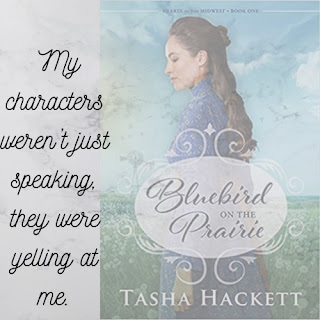
I believe other authors would agree with me when I say, sometimes the stories we write don’t even feel like our stories, but these characters come to us and we have to get to know them and find out what they need and what they want, and then let them tell their own story. That’s not something I understood until I experienced it. Sometimes Zeke would say things to Eloise and I would simply step back and think, “Whaaa? You are so smart. Where you did you learn this?”
Listen to this one. I found it written in my notes, but I didn’t put it in the novel because it’s so good I honestly don’t know if I stole it from someone else and didn’t credit them. From Zeke’s outlook in life: “Hardship does not have the power to rob us of hope for the future.” And, “Happiness and love are granted to all who SEEK IT OUT.” My character said that. Not me. I’d never say that. Tasha would say, “Fool me once . . . I’m going to be super, doubly sure to be prepared and put up lots of walls so I don’t get hurt again.” Zeke knew better, and he’s a pretty wise dude. He’s clumsy as all get out and oblivious to most things. But still. He’s got great morals.
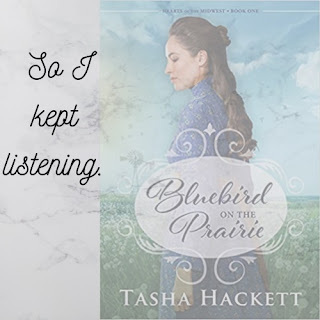
There I am, back in 2018 trying to write a book, but I can’t figure out what to do for my character Eloise. Because I hadn’t yet found the hope after my own grief. How could I possibly write it for her when I didn’t understand it myself? I’m not (and wasn’t) a widow. But I understand a fair amount of grief. I’m telling you today there is hope after grief. I’m also the girl who couldn’t write that story when I first tried. God had quite a bit of work to do in me (and will continue until I die). I had my fourth child and stopped writing for a season while I learned a hard and beautiful lesson. Namely: There is hope after grief. Zeke and Eloise kept dancing around in my imagination and I kept listening and getting to know them. Finally they were ready to share the rest of their story in Bluebird on the Prairie. A bluebird symbolized hopeto me with a nod to Emily Dickinson's poem, “Hope is the thing with feathers,” and what with the bluebird coming back each spring.
Bluebird on the Prairie is available wherever books are sold and my website. You can find it at Walmart.com, Amazon, Barnes & Noble, or my favorite: request from any local bookstore. As a special thank-you, email me a copy of your receipt and I’ll send you Four Ways to Recover Hope. These are four tangible things that I found to be encouraging as I processed my own struggles.
I’d love to get to know you, too! How have your characters been speaking to you? How have you rediscovered hope? You can find me on Instagram @hackettacademy and my website www.TashaHackett.com and email tasha@tashahackett.com
Bluebird on the Prairie
by
Tasha Hackett
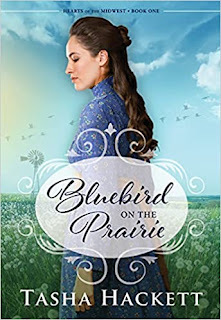
Haunted by nightmares after her husband's death, Eloise Davidson struggles to find peace. Avoiding the town and the people in it has become part of who she is. When she meets a traveler who falls at her feet, she is more than willing to forget the whole embarrassing thing ever happened. Eloise has enough to worry about without entertaining silly daydreams. But when Zeke threatens the safety net she’s built around herself, she’s not prepared for how her world will change.
Amazon.com: Tasha Hackett: Books, Biography, Blog, Audiobooks, Kindle
Bluebird on the Prairie : Hearts of the Midwest - 1 (Paperback) - Walmart.com
May 25, 2022
A Deep Dive into Newsletter Subscribers

by Pam Hillman
Let’s talk about newsletters. Specifically, newsletter subscribers.
And… as usual, at the last minute, I figured out how to find the 0% Open and 0% Click throughs, so this post, as well as my time spent whittling my list down, could have been a LOT shorter. But a hard lesson learned is one well learned. So if you're strapped for time, just scroll to the bottom.
We've all heard the following mantras: “More than anything else, grow your newsletter list”. Or “Your newsletter subscribers are GOLDEN”. “You have control of the email addresses entrusted to you by your fans, not Facebook, Twitter, etc.”
You get the drift. All of that is true and we jump through hoops to be part of promotions and giveaways to grow our mailing list. Nothing wrong with that.
And newsletter services took note. As your subscriber base grows, you’ll have to pay for an account. Nothing wrong with that, either. But what isn’t said most of the time is that it’s just as important (more so!) to manage your subscribers after you get them as it is/was to get them in the first place.
First, there is a ton of information online about what to do and not do with newsletters, how to manage subscribers, and which service providers are best for you. But that’s the problem. There is SO much information that I could never figure out what I needed to know and what I didn’t. So it was easier to just keep building my list. 500 subscribers. 2k. 3k. Wow! How exciting!
Not exactly.
A few years ago, I had to go to a paid plan, and it’s been costing me about $500 a year. So this month I finally took the time to really dig into my newsletter service and the fees I've been paying. I’m not sure I’m providing any new information for your toolbox, but it was new to me, so here goes…
I wish someone had told me in simple language how important it is to review my lists on a regular basis, because if I had, without a doubt, I wouldn’t have had to upgrade to a paid service plan during the last 3-4 years. You do the math. 4 years x $500. Gulp.
So, it is a good idea to figure out how your service (Mailchimp, Mailerlite, Constant Contact, etc.) works and manage it effectively… before you get to the stage that you’re forced to pay handsomely for the service.

I have Mailchimp, so most of what I’m going to talk about is specific to that service provider, but (in general), it should apply to whatever service you’re using, depending on how many subscribers and email sends you’re allowed.
And, yes, I could switch from Mailchimp to a different provider, and I may at some point. But the bigger and more urgent problem was that I had a lot of contacts on my list who weren't engaged and were costing me money.
Things I wish I’d paid attention to for the last 10+ years:
SubscribedUnsubscribedCleaned Email AddressesArchived Email AddressesWhile Subscribed, Unsubscribed, and Cleaned sounds self-explanatory, from what I’ve gathered, it is not. Or at least the gazillion posts I waded through made it seem that way. As best as I could tell, Subscribed AND Unsubscribed count toward your billing on Mailchimp with their current plans. Which makes no sense at all. Unsubscribed is unsubscribed, but whatever.
I could be wrong, though, since I was on a “Legacy” plan up until I started this “clean-up” journey. But I don’t think Mailchimp was charging me for the 870 unsubscribed emails on my list. Also, cleaned email addresses are those that pretty much are going into a dark hole, so according to Mailchimp, you shouldn’t be charged for those, but you can’t archive them either. As one article said, they’re just “dead in the water”.
Regardless, since I didn't want to see those 870 unsubscribes on my list, I archived them as Mailchimp was very clear that no matter what plan you were on, you would not be billed for ARCHIVED email addresses.
Now let’s talk about the following…
RatingsSegmentsTagsOpen RateClick RateMailchimp gives each subscriber a Rating of 1-5, and it’s not very accurate, imo. But at least it’s a starting point.
Mailchimp makes it easy to Segment your lists in all sorts of ways, and Ratings is one of them. According to one of those “know everything” articles, if you’re going to archive a group of contacts, the #2 group is the one to archive.
Think of Ratings, Segments, and Tags as a big picture, little picture scenario, or using Segments and Tags to “drill down” on your subscribers. I’m currently using it to whittle down my inactive subscribers, but it’s a good way to BUILD UP your list as well. Hopefully, we'll talk about that in a later blog post in a month or two.
I segmented my lists this way for now:
#1 Rating - According to Mailchimp, these recipients have either unsubscribed and resubscribed, or soft bounced in the past.
#2 Rating - These rarely engage, but all new subscribers start out as #2 rating, so you can't just willy-nilly archive all of the #2 ratings.
#3-#5 Rating - These are supposed to be the most engaged. Later, I will segment these out in order to send targeted campaigns to my most engaged subscribers.
I’m in the process of going through 800 subscribers who have a #2 rating but signed up at least 2 years ago and as far back as 2011. These subscribers rarely engage according to MC. But #2 is weird, because some of these people have a 15-30% open rate, so that’s why I’m manually going through these. Granted, click rate is much more important than open rate, and I’ll talk about that a bit more below.
Where do Tags come in? You can do ANYTHING you want with tags. I had over 700 in my segment of #2 rating of subscribers who’d been with me 2 years or longer, but hadn’t opened anything in a long time, if ever. I needed a way to manage that group in small chunks as I only needed to reduce my subscriber base a couple hundred to downgrade to the free account.
Now, here's where I wasted some time over the last few weeks. At night, while sitting around watching tv with hubby, I’d pull up the #2 rating segment, tag a group of 50 with a temporary tag of SMALL GROUP, then I’d manually check that group to see what their open/click rate was. Sometimes I’d even look at their history a bit. Once I decided to archive them, I added an ARCHIVE tag and removed the SMALL GROUP tag and they would immediately disappear from my “small group of 50” that I was working on. Every few hours or every couple of days, I’d look at the group I’d decided to archive (tagged appropriately as ARCHIVE), choose them all, and actually archive them. Clear as mud, yes? lol
Oh, and while I was at it, I added tags like “Do Not Archive”, “5%+ Click Rate” to those I was keeping. I’m nowhere near done, but I met my goal of whittling down below 2000. From now on, I’ll only archive subscribers that have a 0% Open Rate AND a 0% Click Rate and have been on my list for years.
Here’s an important tip: If your list isn’t out of control like mine was, start learning how to manage it now. On the other hand, if you have THOUSANDS of (as in 20, 30, 80 THOUSAND) subscribers, I can’t help you! But maybe YOU can help the rest of us! Do tell your secrets for such a robust list. lol
Final Takeaways:
DO learn how your provider works.DO learn about segments and tags.Don’t just blindly archive based on Mailchimp’s ratings. Many of my 2 star ratings have a 30-40% open rate.DO review your list regularly. If you only have a few hundred subscribers, the time to start is now. If you don’t want (or need) to archive anyone yet, at least segment them so that you can manage them better when the time comes.Do I WANT to be below 2000 subscribers just so I can have the free plan? No. But if 500-1000 subscribers haven’t opened or clicked anything in 3 or 4 years — if EVER — then there's no need to pay to send them an email that they aren't going to look at. At least for now.Are these archived subscribers gone forever? Again… no. As I learn more about how to improve my open and click rates, I can test drive some of these guys. Maybe even unarchive in small groups and alert them to a new release and see how they respond.
Final, Final Takeaway
As I was finishing this up, I went back into my Mailchimp account and searched one last time for 0% open rate and 0% click rate and I found it. Sigh. The thing is, there are many different ways to search for your subscribers and determine if they haven’t been engaged at all, ever. I hated archiving ANY of mine, but it had to be done.
Here's an example of a segment with 3 parameters. It's before 12/31/2018, a 0% Open Rate, and 0% Click Rate, AND has not opened any of the last 50 Campaigns. Contact can match "Any" or "All" of the conditions you assign.

Here's the dropdown menu that you can choose to determine your segment. So many options!
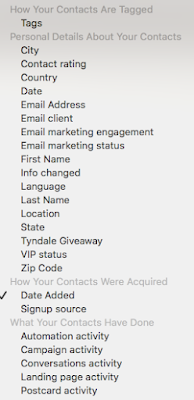
And then this dropdown shows all the options for how the campaigns were opened or not opened. There are similar dropdowns regarding dates. You just have to think through what you're looking for.
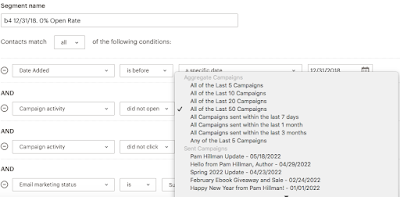
This screenshot is a sampling of some of the tags I've been using. Again, tags are different to segments. Segments come directly from the FIELDS that Mailchimp has set up. There is ONE tag field, but you can tag a contact multiple times if need be. Tags will likely be unique to you and your needs at the time.
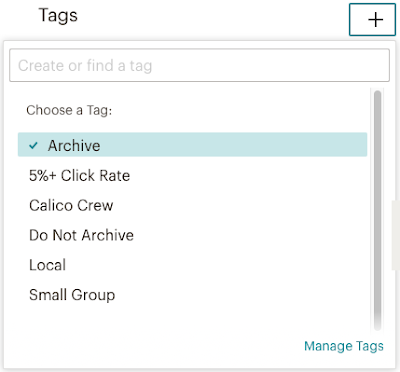
Well, that's a lot to take in. But if you take anything away from this, just know that if you have a small list that's on the verge of having to move to paid or is already on a paid plan, you might have options if you look more closely at your subscribers.
May 24, 2022
Why Do We Write?
Hello Seekerville. 👋
Cate here.
They say confession is good for the soul, so I'll start with a confession right up front.
I haven't been writing much lately - like at all!
And it's killing me!
I'll come back to that in a minute, but I had to get it off my chest up front before we delve into a discussion.
I just finished reading a book with my class.
Peak by Roland Smith is the story of a young boy climbing Mt. Everest. It's a wonderful adventure story full of conflict and challenges, and my 7th grade boys were hanging on every word. To be honest, I was too. I read this book with a class almost every year, and I still love reading it.
It's fun to read through my post-it notes to see what kinds of things I've taken note of in the past and what my thoughts were as I read it each time.The colors of the notes change from year to year so I can see what was different in my thinking. But one question is consistent across the pages and across they years. WHY???
Why would anyone put themselves through what these characters are enduring just to get to the top of a mountain?
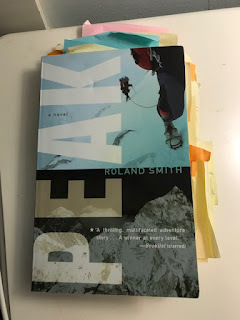
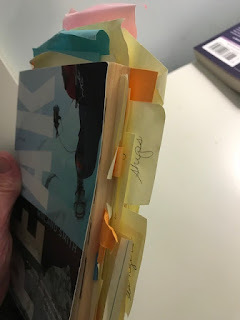
Peak is a wonderful book to use to teach students about conflict because there are so many kinds - Peak vs nature, Peak vs his father, Peak vs society, Peak vs himself. The novel is also easy for teaching plot structure because the climax occurs literally at the peak of the mountain. Everything after is just downhill.
But maybe you're asking why am I writing about a middle grade novel?
It comes back to that question WHY???
Why do climbers risk very probable death to climb a mountain. As the title character, Peak Marcello, wisely states: The only thing you’ll find on the summit of Mount Everest is a divine view. The things that really matter lie far below.
So why?
Do you ever ask yourself that about your writing?
Why would anyone put themselves through this???
Why would anyone face tight deadlines and endless revisions only to risk harsh reviews and uncertain sales?
Let me digress a moment before I answer that.
I saw a tweet this morning asking would you:
a) drive 100 miles to meet your favorite author in person, or
b) stay home and use the money to buy more of her books.
There was a wide range of answers from people who would drive AND buy all the author's books to be signed to people who felt so introverted they knew they would back out at the last minute.
Yesterday Laurel Blount was talking about how wonderful it is to get away with other writers because they get us.They get the struggle. That's so very true. Unfortunately it's not always possible.
But during the pandemic, this desperation of authors to connect yielded some cool opportunities. Multiple virtual events sprang up. Some were hosted by individual authors on FB live. Julia Kelly started Ask an Author (a FB group with over a million members)
Some were also hosted by bookstores looking to stay afloat and help readers stay connected to their favorite authors. It turned out the advantage was many more people were able to attend than on an in-person author event. I remember at one point being able to chat with authors almost every night of the week!
Friends and Fiction started out as a chat between five authors who happened to be friends but who also had books releasing in the spring of 2020 and had no idea how to marker them. The weekly chat sessions spawned a FB group with over 70,000 members! If you need a writing fix (and writing tip from well-known authors) then this is the place to be on Wednesday nights.
Last week the 4 friends interviewed Laura Dave. They were talking about her mega best-selling novel and they were also talking about how to fit writing time into a busy life. Almost everyone agreed they had to do it first thing when they got up or it just didn't happen - because writing is so hard!
It is hard work. Incredibly rewarding hard work, but mind-blowing, exhausting, draining work - and that'a when it's going well.
So that brings me back to my question - why do we do it???
We all have our own reasons, but I think it's similar to the reasons people have for climbing Mt. Everest - because we have to. There's something inside us begging for release. We crave the rush of putting words on paper. we have stories that need to be told. We don't know how not to write.
Remember I said I'd come back to the not writing part. Work, family demands, stress - all of these have kept me from writing lately - but you know what - they left me CRAVING time to write. The need to dwell in my stories became a physical ache. I had to write.
I'd love to hear your thoughts on why you write.
Or if you don't write - and you are an avid reader - I'd love to hear your thoughts too.
Why do you do it?
May 23, 2022
The Power of Connection with Guest Laurel Blount
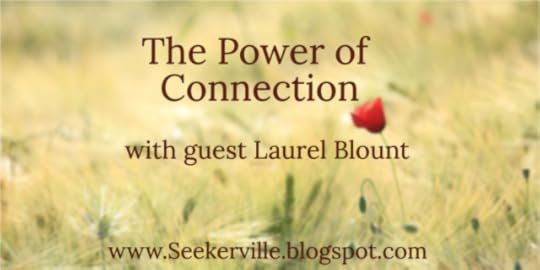
by Laurel Blount
Writers are weird.
Oh, don’t look at me like that. We all know it. Of course, we’re weird in the best possible way. Our uber creative minds are crammed with vivid imaginings, half-baked plots, and all too often, a nail-biting anxiety about reviews and sales. We argue out loud with people we invented, we dash dripping out of our showers to jot down scene notes, and some of you (cough-cough suspense writers cough-cough) have a Google history that could get you placed on watch lists. (If you want to have nightmares, go on a hike with a suspense author. They see body-hiding potential everywhere.)
So it stands to reason that sometimes the people who understand us best are other writers.
Recently, I went to Florida on a Christian writers’ retreat with fourteen fellow authors. We stayed in gorgeous condos overlooking the bay, and we ate scrumptious food. And that was all very nice. But you know what the most wonderful thing was?
The talks, hands down.
Because we writers “get” each other. We understand the blessings and the pitfalls of this unique profession in a way outsiders (or civiliansas Lenora Worth affectionately calls them)--even the ones who love us dearly--can’t.
Let me tell you, the conversations rolled at this retreat, and each one was a feast of comradery and wisdom. We discussed heart-breaking revisions, pressure-inducing deadlines, frustrations, joys, successes and failures.
No matter what you brought up, somebody in the group would say, “Oh, yeah. That’s happened to me, too! Let me tell you what I did…”
C.S. Lewis believed this is the point where the richest friendships are born--in that moment when we feel connected to someone else through a shared experience or opinion. When someone exclaims, “You, too? Really? I thought I was the only one!”
Understanding this is so important for authors. First of all, because, like I said, as writers we need the unique connections we can form with our fellow creatives. I came home from that retreat feeling energized and refreshed, armed with new friendships that I’m truly thankful for.
Secondly, we need to understand this concept because we can leverage it in our writing to forge strong emotional connections between our characters and our readers. Let me tell you how that works for me:
In every story, I try to forge several emotional points of connection between my main characters and my reader, preferably beginning at the very start of the book. I like to begin with some tiny, shared experience that will resonate in my reader’s heart. I want her to think, Oh, yes! I know just how that feels. Been there, done that!
I think this is a powerful tool, and it seems to work well. I get a lot of reviews that say, “I felt like the characters were my friends!” “I was drawn in right from the start.” Those comments always make me smile--that’s exactly the reaction I want!
So, how to choose a situation to create this connection? Easy--just pick a small, everyday experience that meshes well with both your plot and your character’s situation and personality.
For example, in my very first Love Inspired book, A Family for the Farmer, I started off with my heroine waiting in an attorney’s office with her young twins. The lawyer’s running late, and her twins are cranky and hungry. One of the kids asks for a hamburger, and the other one reminds her--loudly--that there’s never any money for hamburgers because they’re broke. Our heroine cringes and shoots an embarrassed glance at the lawyer’s sleek secretary.
So what are the points of connection here? Being forced to wait on someone who’s late, while wrangling hangry children. Being short on cash. Feeling ashamed when a child blurts out something personal--and not too flattering. Can you identify? I sure can--and I think most of our readers can, too.
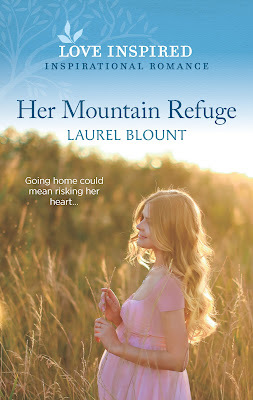
Here’s another example. My new Love Inspired, Her Mountain Refuge opens with the heroine in a very different--but also highly relatable--predicament. Take a look:
Uh-oh.
Charlotte Tremaine froze midway through buttoning the forty-two tiny buttons scattered up the back of her client’s one-of-a-kind wedding gown. Her heart dropped right past her seven-months-and-counting baby bump and hit the overpriced shoes her mother-in-law had insisted she buy for Dylan’s funeral.
She gave the gaping fabric a hopeful tug.
Not a chance.
Charlotte’s heart started to pound. This was not good.
Pippa Sheridan was a gold-plated pain, but her dress was a triumph, if Charlotte did say so herself. It was a sleek dream of heavy satin and handmade French lace, vintage in its choice of material and refreshingly trendy in its cut and drape.
It was also way, waytoo small.
Now, maybe we’re not wedding dress designers like Charlotte Tremaine, but who among us hasn’t had an uh-oh moment like that? A sickening moment when our heart sinks, and we realize we’re in big, big trouble?
We’ve all been there, haven’t we? And that fellow feeling gives us a strong point of connection with Charlotte. Our hearts go out to her--and we want to know what will happen next.
I believe this works because deep down, we all hunger to feel like we’re really not so weird after all. Other people have their uh-oh moments, too. And when we have a you, too? experience with someone, we feel a special compassion for their struggles.
When I went to the writers’ retreat, I was reminded that I wasn’t so weird, after all--at least not among other authors. The more we shared the common struggles of writing--and life--the more connected, accepted and compassionate we all felt.
It can work the same way for our readers. The more of these universal experiences we can sprinkle in our story, the more attached they’re going to feel to our characters. And the more connected they feel, the more they’re going to care about what happens to this story person--and the less likely they are to put down the book!
I’d love to hear your thoughts on this--as readers and/or writers! Leave a comment to be entered to win signed copies of both Her Mountain Refuge and the first book in the Cedar Ridge collection Lost and Found Faith!
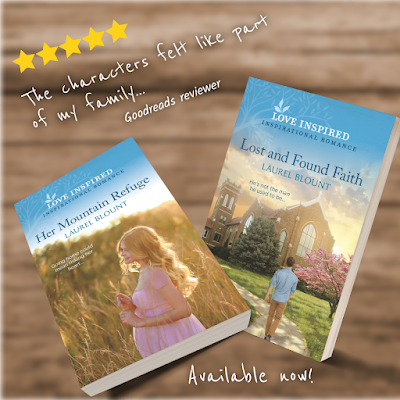

An enthusiastic multi-tasker, Laurel writes for both Berkley/Penguin Random House and Love Inspired/Harlequin. She’s the recipient of ACFW’s Carol Award, The New England Reader’s Choice Award and GRW’s Maggie Award. She’s represented by Jessica Alvarez of Bookends Literary Agency. Her Mountain Refuge is Laurel’s eighth book.
May 22, 2022
Yay for a Second Printing!
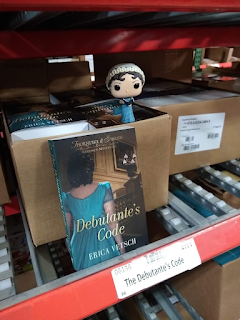 Jane sitting on a case of reprinted
Jane sitting on a case of reprintedcopies of The Debutant's Code in the
Kregel Warehouse. Jane is my little mascot and
traveling buddy. :)
I’m thrilled to announce that The Debutante’s Code has gone into its second printing! Why am I so excited? Because reprints mean a few fun things for a writer.
1. Your book is selling well. Both the buy in and the sell through. What are those, you ask?
Buy in – Initial orders, including pre-orders of your book. Bookstores and book buyers look through your publisher’s catalog and place orders of new releases. They buy the book into their store. Over the initial period of about three months, your goal is to sell those copies bought in and not have the store return them as unsold.
Sell through – This is when the books that have been bought in have sold, and the bookstore orders again. This takes place 3-9 months out from the release date. Publishers track these numbers closely. Sell through means your book is doing well.
2. Good sales numbers result in happy publishers and happy authors. It can mean a bit of extra marketing money allocated to your book, and it can also help the author land that next contract with the publisher.
3. It means you are reaching readers. This often means in uptick in review numbers, visibility, and buzz about your books. More interactions with readers online, emails, etc. Requests for interviews, guest blog posts, articles, etc. And it means readers will suggest your book to others, in online groups, and in person, which then can mean more books purchased.
All those things are pretty universal for traditionally published authors. For me, there were a couple of other bonuses for me this time around.
1. Due to a printer error, the cover of The Debutante’s Code came out much darker than we anticipated. While we wanted a mysterious cover, the first printing’s cover was soooo black. For the reprint, the publisher was able to stipulated that the cover be much brighter. I love round two, because Juliette’s hair doesn’t disappear into blackness in the corner, and you can actually see what’s in the painting.
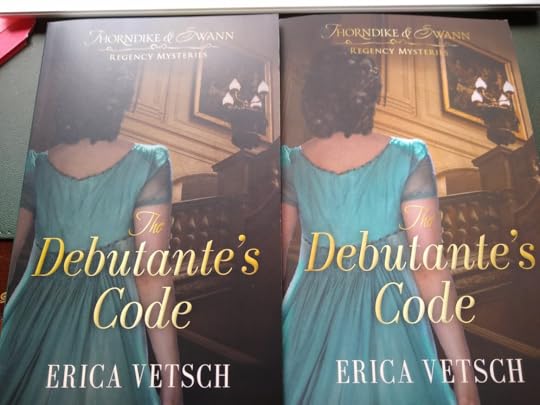 First printing on the left, second on the right.
First printing on the left, second on the right.2. There was an error on the back cover copy, too, in round one! Our hero, Daniel Swann, was incorrectly called Daniel Thorndike! Yikes! I was so bummed when I saw that. However, in the vein of making lemonade with lemons, I had a little award designed for those eagle-eyed readers who noticed and contacted me. I replied with the graphic, and the words “You would make a great Regency Spy. As one of the few who have found the typo, you are the winner of The Spyglass Award.” Readers got to feel clever, and one lady even said she was going to display the award on her blog.
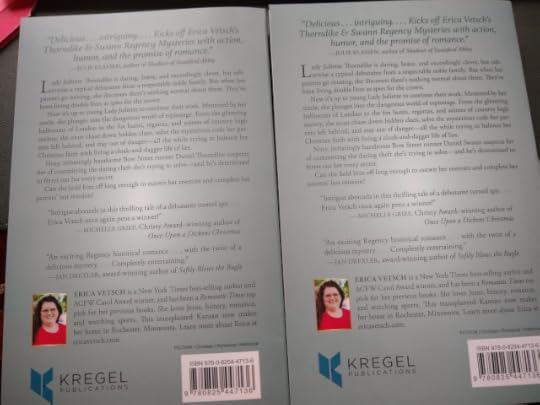 Can you see the typo?
Can you see the typo?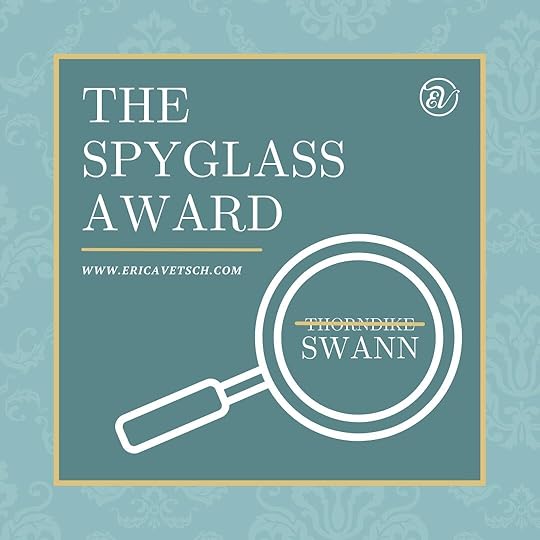
I was blessed to be able to visit my publisher in Grand Rapids, MI about 10 days ago, and to get to speak to the owner, the publisher, editorial, and marketing. That face-time is invaluable! We talked about Millstone of Doubt, coming out this September, and Children of the Shadows, which will release in 2023, as well as some new projects! I’m thrilled!
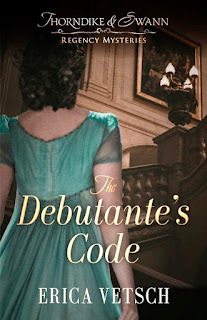
Jane Austen meets Sherlock Holmes in this new Regency mystery series
Newly returned from finishing school, Lady Juliette Thorndike is ready to debut in London society. Due to her years away, she hasn't spent much time with her parents, and sees them only as the flighty, dilettante couple the other nobles love. But when they disappear, she discovers she never really knew them at all. They've been living double lives as government spies--and they're only the latest in a long history of espionage that is the family's legacy.
Now Lady Juliette is determined to continue their work. Mentored by her uncle, she plunges into the dangerous world of spy craft. From the glittering ballrooms of London to the fox hunts, regattas, and soirees of country high society, she must chase down hidden clues, solve the mysterious code her parents left behind, and stay out of danger. All the while, she has to keep her endeavors a secret from her best friend and her suitors--not to mention nosy, irritatingly handsome Bow Street runner Daniel Swann, who suspects her of a daring theft.
Can Lady Juliette outwit her enemies and complete her parents' last mission? Or will it lead her to a terrible end?
 Best-selling, award-winning author Erica Vetsch loves Jesus, history, romance, and sports. She’s a transplanted Kansan now living in Minnesota, and she is married to her total opposite and soul mate! When she’s not writing fiction, she’s planning her next trip to a history museum and cheering on her Kansas Jayhawks and New Zealand All Blacks. You can connect with her at her website, www.ericavetsch.com where you can read about her books and sign up for her newsletter, and you can find her online at https://www.facebook.com/EricaVetschAuthor/ where she spends way too much time!
Best-selling, award-winning author Erica Vetsch loves Jesus, history, romance, and sports. She’s a transplanted Kansan now living in Minnesota, and she is married to her total opposite and soul mate! When she’s not writing fiction, she’s planning her next trip to a history museum and cheering on her Kansas Jayhawks and New Zealand All Blacks. You can connect with her at her website, www.ericavetsch.com where you can read about her books and sign up for her newsletter, and you can find her online at https://www.facebook.com/EricaVetschAuthor/ where she spends way too much time!May 21, 2022
Sunday Scripture & Prayer Requests
SIXTH SUNDAY OF EASTER
 The Adoration of the Trinity by Albrecht Dürer (1511),
The Adoration of the Trinity by Albrecht Dürer (1511),
Vienna, Austria. [PD-US]
Jesus said to his disciples:
“Whoever loves me will keep my word,
and my Father will love him,
and we will come to him and make our dwelling with him.
Whoever does not love me does not keep my words;
yet the word you hear is not mine
but that of the Father who sent me.
“I have told you this while I am with you.
The Advocate, the Holy Spirit,
whom the Father will send in my name,
will teach you everything
and remind you of all that I told you.
Peace I leave with you; my peace I give to you.
Not as the world gives do I give it to you.
Do not let your hearts be troubled or afraid.
You heard me tell you,
‘I am going away and I will come back to you.’
If you loved me,
you would rejoice that I am going to the Father;
for the Father is greater than I.
And now I have told you this before it happens,
so that when it happens you may believe.”
John 14:23-29
CONGRATULATIONS TO ALL THE GRADUATES!
The Seekerville bloggers are praying for YOU and for our entire blog community. If you have any special intentions that need additional prayer coverage, leave a request for prayer in the comment section below.
Please join us in praying for our country and for an end to the rising economy. Also, please pray for the people of Ukraine, for a halt to Russian aggression, and for the protection of our military.GOD BLESS THE USA!
We are so grateful for all of you—for your friendship and your support!
May the Lord bless you and keep you safe.
May 20, 2022
Weekend Edition


If you are not familiar with our giveaway rules, take a minute to read them here. It keeps us all happy! All winners should send their name, address, and phone number to claim prizes. Please send to Seekerville2@gmail.com. If the winner does not contact us within two weeks, another winner may be selected.
Monday: Jan talked about writing as both an art and a business. Winner of an e-book copy of Jan's new release, , The Sign of the Calico Quartz, is Connie Porter Saunders!
Wednesday: Debby Giusti blogged about Inspirational Travel and the historic train ride she took. The winners of her June two-in-one, Soldier Protector, are Jeanne Crea and JPC Allen. Congrats, ladies.
Thursday: Winnie gave us an early look at her upcoming release, Her Amish Springtime Miracle. The winner of a copy of the book is Sarah Taylor
Friday: Jennifer Beckstrand provided a guest blogpost on "Character and Characterization." Digital copies of THE PEANUT BUTTER CHRISTMAS go to KB, Edwina and Sandy Smith. Congrats to the winners!

Monday: Erica will have some fun news and a chat about second printings.
Tuesday: Laurel Blount has a brand-new release and she'll be here to tell us all about it.
Wednesday: Cate Friday: Pam shares a few hard-fought tips about wrangling newsletter subscribers.

Coming August 23rd!Preorder now!

She came home to make things right. Will she be given a second chance?
Gloriana Prescott has returned to her Texas hometown to make amends—even if the townsfolk she left behind aren’t ready to forgive. But when her mother’s ranch manager, Justin Broussard, is tasked with saving the struggling rodeo so his teen daughter can compete, Gloriana sees a chance to prove she’s really changed. But can she prove to Justin, and the town, that she’s trustworthy?
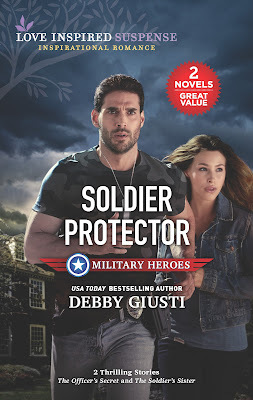 Pre-order NOW!
Pre-order NOW!Releasing on Wednesday, May 25th!
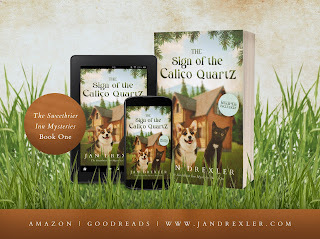
Preorder Here!
Releasing On Tuesday MAY 24
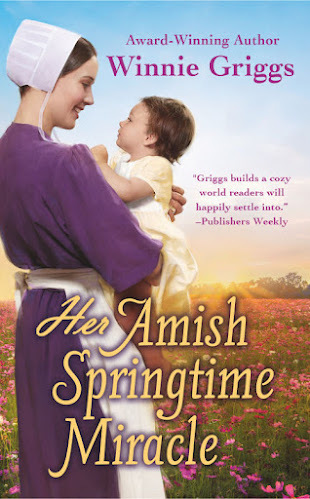
An orphaned baby brings together an unlikely couple who learn the true meaning of family.
When Hannah Eicher discovered sweet baby Grace in her barn last spring, the adorable infant seemed like the answer to her prayers. The young Amish baker has always wanted a familye of her own and now that she’s fostered Grace for nearly a year, her adoption application is almost certain to be approved. But an unexpected visitor to Hope’s Haven could change everything . . .
Preorder Here
And in honor of this upcoming release Winnie has a fun giveaway going on right now. The prize for TWO lucky winners will be a gift box comprised of the first book in the series, a dragonfly bookmark, an insulated mug, a Home Sweet Home figurine and a foldable nailfile. To learn more and to get your name in the hat, look for details HERE
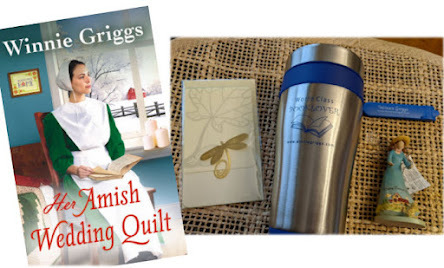

The Latest Writing Tools by LA Sartor at An Indie Adventure
Writing, Independence, and Selling Direct by Derek Sivers at The Creative Penn
What is the Climax of a Story? by Gloria Russell at Write To Done
The Conference Appointment by Tamela Hancock Murray at Steve Laube Agency
Outlining Your Novel for Success by CS Lakin at Live Write Thrive
How a VA Helps Indie Authors Build Their Careers by Clare Flynn at Alliance of Independent Authors (ALLi)
Writers: Pantser, Plotter ... Roadster? by William F Wu at Writers In The Storm
6 Vellum Alternatives: Other Formatting Software by Jason Hamilton at Kindlepreneur
Ways to Find Your Best Ideas Before Writing by KM Weiland at Helping Writers Become Authors
Some Thoughts on Publishing by Mary Gillgannon at Rocky Mountain Fiction Writers blog
May 19, 2022
Character and Characterization by Seekerville Guest Jennifer Beckstrand
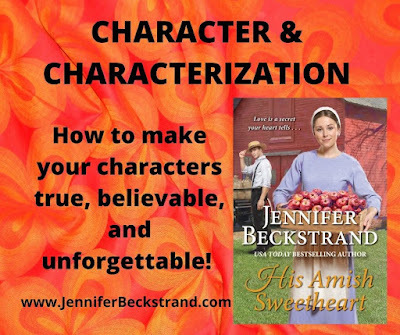 Hi Dear Friends! Debby Giusti here to introduce Jennifer Beckstrand, a Bestselling Author of Amish Stories, who is blogging with us today. She's written an amazing post that I'm sure you'll enjoy.
Hi Dear Friends! Debby Giusti here to introduce Jennifer Beckstrand, a Bestselling Author of Amish Stories, who is blogging with us today. She's written an amazing post that I'm sure you'll enjoy. Character and Characterization: How to make your characters true, believable, and unforgettable!
Join me in giving Jennifer a warm Seekerville welcome!
Here's Jennifer:
I’m so excited to be here today to talk about one of my very, very favorite topics: writing great characters.
All great stories are about great characters. How do we as writers bring our characters to life?
Have you seen the movie “Hitch” with Will Smith and Kevin James? If you haven’t or even if you have, watch this scene on YouTube where we’re introduced to Albert Brenneman: https://www.youtube.com/watch?v=MIBzV...
Be sure to come right back to join in the discussion.
Albert Brenneman is one of my favorite characters ever. In the movie, the director does several things to reveal Albert’s character to us and more importantly, make him instantly likable.
· Albert spills mustard on his pants—This immediately makes him relatable. We’ve all felt klutzy on occasion.
· He displays wide-eyed hope, and we can tell he sincerely likes the girl he wants to get together with. This makes him likable.
· He doubts himself again and again and has us rooting for him from the very beginning. This makes him vulnerable.
· He doesn’t have a perfect body or perfect hair. He wears glasses, and he gets down on himself for saying the wrong thing. This makes him believable.
Think of your favorite characters in books and movies. Why are they your favorites?
I could spend three weeks talking about how to create amazing characters, but none of us have that much time, so I’m going to focus on just a few aspects of creating great characters.
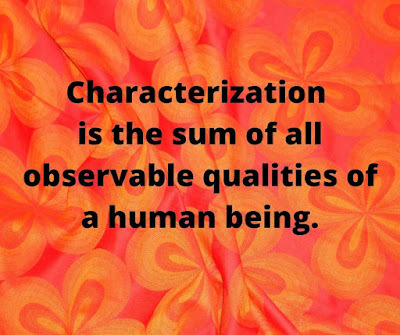
#1 Characterization is the sum of all observable qualities of a human being.
Character and characterization are different. Some people call characterization the driver’s license information. I like to think of characterization as the first few layers of a character.
Characterization can reveal character or hide it. What are some characterizations of Albert Brenneman in the above YouTube clip that reveal character?
· His photo: He’s awkward
· His clothes: He’s a professional but not a player
· His insecurity: He’s vulnerable, sincere, and lovable
In his must-read book, Story , Robert McKee says, “The revelation of true character in contrast to characterization is fundamental to all fine storytelling.”
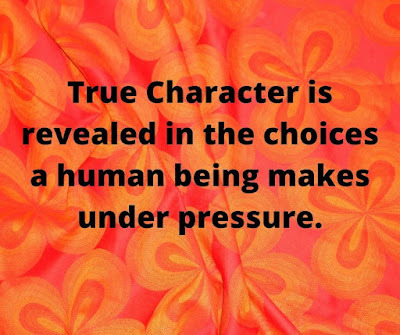
#2 True Character is revealed in the choices a human being makes under pressure—the greater the pressure, the deeper the revelation, the truer the choice to the character’s essential nature.
What choices does Albert make in this scene that reveal more of his character?
He is eager to give Allegra a pen, he gets frustrated, he decides to walk away.
What choices does Hitch make that reveal more of his character?
He listens, he laughs, he encourages, he’s kind
Pressure and conflict often reveal a person’s true character. “Pressure is essential. Choices made when nothing is at risk mean little.” (Story by Robert McKee)
Robert McKee gives a good example of pressure revealing character:
Consider this scene: Two cars motor down a highway. One is a rusted-out station wagon with buckets, mops, and brooms in the back Driving it is an illegal alien- a quiet, shy woman working as a domestic for under-the-table cash, sole support of her family. Alongside her is a glistening new Porsche driven by a brilliant and wealthy neurosurgeon. Two people who have utterly different back- grounds, beliefs, personalities, languages-in every way imaginable their characterizations are the opposite of each other.
Suddenly, in front of them, a school bus full of children flips out of control, smashes against an underpass, bursting into flames, trapping the children inside. Now, under this terrible pressure, we'll find out who these two people really are.
Who chooses to stop? Who chooses to drive by? Each has rationalizations for driving by. The domestic worries that if she gets caught up in this, the police might question her, find out she's an illegal, throw her back across the border, and her family will starve. The surgeon fears that if he's injured and his hands burned, hands that perform miraculous microsurgeries, the lives of thousands of future patients will be lost. But let's say they both hit the brakes and stop.
This choice gives us a clue to character, but who's stopping to help, and who's become too hysterical to drive any farther? Let's say they both choose to help. This tells us more. But who chooses to help by calling for an ambulance and waiting? Who chooses to help by dashing into the burning bus? Let's say they both rush for the b u s - a choice that reveals character in even greater depth.
Now doctor and housekeeper smash windows, crawl inside the blazing bus, grab screaming children, and push them to safety. But their choices aren't over. Soon the flames surge into a blistering inferno, skin peels from their faces. They can't take another breath without searing their lungs. In the midst of this horror each realizes there's only a second left to rescue one of the many children still inside. How does the doctor react? In a sudden reflex does he reach for a white child or the black child closer to him? Which way do the housekeeper's instincts take her? Does she save the little boy? Or the little girl cowering at her feet? How does she make "Sophie's choice"?
#3 A compelling character needs to be
Likable
Believable
Relatable
Vulnerable
Not all characters in your book are going to be all of these, especially your villains, but remember that your villain is the hero of his own story. Your main protagonist should be all of these things:
Likable
Is the protagonist someone the reader can root for? I love the first scene in “Iron Man” when Tony Stark is riding in the Humvee with a bunch of soldiers. The way he talks and relates to the other soldiers makes him immediately likable. Albert Brenneman is another character that I think is instantly likable. However, your protagonist doesn’t have to be likable all at once. (Think Ebeneezer Scrooge or Mr. Darcy.) In one of my first Amish books, Miriam’s Quilt, Miriam is quite a snob, but life hands her some setbacks, and she comes to know herself. Then we really start rooting for her.
Believable
Is your heroine too good to be true? Too bad to be true? One T.V. series I loved to watch was Poldark, because I thought Ross Poldark was both deeply good and deeply flawed. I really soured on the series when Ross did something that I thought was out of character—I didn’t find him believable anymore. If you create a 75-year-old granny who fights off bad guys with her fists, you’d better show us that she works out five hours a day and drinks protein shakes for breakfast, lunch, and dinner.
Relatable: You want the reader to say, “I totally understand. I’ve been there.” If your characters are too perfect, the reader can’t relate to them. That’s one of the reasons I love the above scene from Hitch. Albert spills mustard on his pants. Most of us have done that and sometimes before a very important appointment or meeting.
Vulnerable: This can mean broken, weak, flawed, or all three. Many of the greatest protagonists are deeply flawed: Sydney Carton in A Tale of Two Cities, Edmund Dantes in The Count of Monte Cristo, and Katniss Everdeen in The Hunger Games. Harry Potter is vulnerable because he is a child. Children are easy to make vulnerable. It’s a little harder to do with adults.
These four things add up to characters that readers care about. Of course, this doesn’t apply to all characters, but readers must care about what happens to your main characters.
Several years ago, I saw the movie “All Is Lost” with Robert Redford—and only Robert Redford. Who doesn’t love a Robert Redford movie? As it turned out, “All Is Lost” was a mediocre movie because even though Robert Redford was stranded at sea in a dire situation, I didn’t care what happened to him. Why not? Because the writer and direction didn’t develop his character. I didn’t know who this “man in peril” really was. And so, I didn’t care. Here is part of a review of “All Is Lost” that expressed it perfectly:
Who is this sailor? Where does he come from? Chandor (the director) never sees fit to tell us. His hero remains a deliberate stencil, defined solely by the crisis around him and the actions he takes. Ironically, given the abundance of ocean, All is Lost is an entirely depthless drama. Here is a film that exists purely in the moment, bouncing us inexorably from the bad to the worse. There is no journey towards redemption and no cozy life lesson lying in wait at the end. There's just the sea and the sky and the struggle to survive.
Plot is essential, but it is well-written characters that really make a great book.
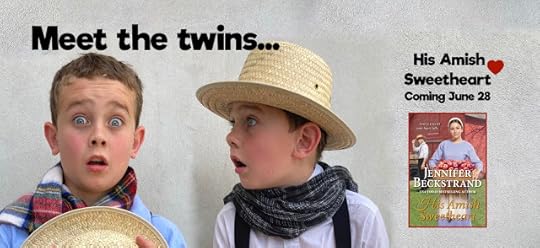 I hope you’ll check out the characters in my next book, His Amish Sweetheart, which comes out June 28. Eight-year-old twins Alfie and Benji Petersheim will do anything to get rid of their brother—even find him a wife.
I hope you’ll check out the characters in my next book, His Amish Sweetheart, which comes out June 28. Eight-year-old twins Alfie and Benji Petersheim will do anything to get rid of their brother—even find him a wife. Don’t miss this delightful love story about friendship, second chances, and smoke bombs. You’re going to fall in love with the characters!
Preorder His Amish Sweetheart on Amazon , Walmart , and Barnes and Noble .
Our very generous guest is giving away three digital copies of
"A Peanut Butter Christmas" which also features the incorrigible twins as they try to create a Christmas miracle for Mary Yutzy. Leave a comment to be included in the drawing!Follow Jennifer Beckstrand:Website: http://www.jenniferbeckstrand.com/Facebook: https://www.facebook.com/jenniferbeckstrandfans
Amazon: https://www.amazon.com/Jennifer-Beckstrand/e/B0073GHCOG/ref=sr_tc_2_0?qid=1488910908&sr=8-2-ent
Instagram: j.beckstrand
Bookbub: @JenniferBeckstrand https://www.bookbub.com/authors/jennifer-beckstrand

